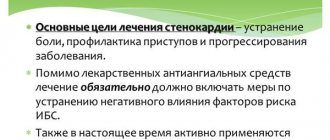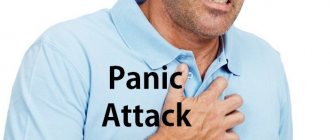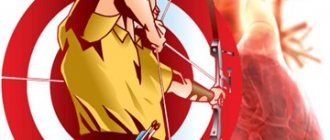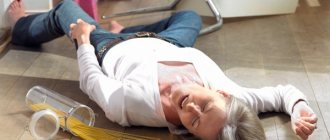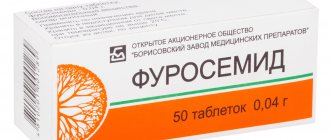Hypertensive crisis is a common phenomenon, so the question of how to treat hypertensive crisis at home is relevant. Many people encounter the disease suddenly; it is important for them to know what help to provide for a hypertensive crisis at home.
An increase in blood pressure (BP) is always unsafe for a person’s life; it requires prompt assistance until the ambulance arrives. A hypertensive crisis is a serious and dangerous manifestation of hypertension.
Symptoms
A hypertensive crisis can develop for the following reasons:
disruption of the central nervous system;- chronic kidney and liver diseases;
- diseases of the endocrine system, excess weight;
- alcohol and nicotine abuse;
- uncontrolled medication use;
- frequent stressful situations.
Since a hypertensive crisis in most cases occurs suddenly, it is impossible to predict the moment of its onset, because sudden changes in blood pressure are individual for each person.
Prerequisites for the crisis:
- constant feeling of anxiety;
- accelerated heartbeat;
- lack of air, rapid and difficult breathing;
- hyperemia and hyperhidrosis – the skin of the face and neck turns red and becomes covered in cold sweat;
- tinnitus and dizziness;
- numbness of the upper extremities;
The first symptoms of the development of the disease may be a feeling of heaviness in the epigastric region, diarrhea not provoked by food poisoning, migraine-like pain in the temporal region, which intensifies with active gestures and turning the head.
During a hypertensive crisis, the patient experiences pain in the occipital region, as well as with active blinking.
The above symptoms signal that irreversible changes are occurring in the vascular system, which can cause GC. Often the development of an attack is not accompanied by prerequisites, and a random jump in blood pressure can occur even in young people. To prevent irreversible consequences of GC, the patient must be taken to a medical facility.
Hypertensive crisis - what is it?
Arterial hypertension often manifests itself as a severe, dangerous complication that threatens a person’s health and vital functions. How does such a critical condition arise? A hypertensive crisis is an attack of a sudden increase in systolic and diastolic pressure. Accompanied by deterioration in the function of certain organs (brain, heart, kidneys). The phenomenon occurs more often compared to a hypotonic attack.
There is no exact starting standard for this diagnosis; all patients have their own working pressure standards, from which its increase and the appearance of symptoms are measured. It is more correct to consider a sharp (over several hours) increase in blood pressure (BP) to personally high levels, accompanied by problems from headaches to disruptions in the neurological and cardiac systems - this is what a crisis is. The situation can be provoked by completely different reasons: stress, changes in weather and climate, alcohol, refusal of hypertensive drugs.
Hypertensive crisis - classification
Based on the type of pathogenesis, there are different types of crises:
- Eukinetic. A common case is that the upper and lower pressure increases rapidly at the same time. Complicated by failure of the left ventricle of the heart, which is fraught with pulmonary edema.
- Hyperkinetic. Upper pressure rises rapidly. There is a throbbing pain in the head, spots appear before the eyes, fever and weakness in the body. The patient feels sick and vomits.
- Hypokinetic. Lower blood pressure slowly increases, headache and dizziness increase. Nausea and vomiting occur.
Depending on the type of organ damage, uncomplicated and complicated conditions can be observed:
- The first option is common for stage I-II hypertension. Against the background of quickly arising symptoms, high blood pressure does not last long, several hours. Medicines effectively normalize the body’s condition and regulate blood pressure.
- The second option is typical for degrees II-III. The crisis is complicated by hypertensive encephalopathy, causing temporary pain and dizziness, and visual disturbances. Gradually, the manifestations increase, and cardiac crisis or ischemic, pulmonary edema, acute renal dysfunction, and loss of consciousness are possible. Signs of an attack may last for some time after the blood pressure normalizes.
First aid
The duration of a hypertensive crisis varies depending on the speed at which symptoms appear. Basically, it lasts 60-120 minutes and is directly related to the state of the body’s compensatory forces. During GC, vital organs do not receive proper nutrition, and the more often an attack occurs and the longer it takes to develop, the higher the percentage of chances of life-threatening complications occurring.
First aid for hypertensive crisis:
- The main rule when a GC attack occurs is not to lose composure.
- The patient should be in a horizontal position, with a pillow placed under the head and shoulder blades.
- If clothing has buttons or zippers, they should be undone to allow maximum access to fresh air.
- A patient without varicose veins can feel better by applying warm lotions or a heating pad to the calf muscles.
- Apply a cold towel to the back of the head.
- Eliminate any possible noise.
Fear of death contributes to the duration of the attack, so the patient must take any drug with a sedative effect.
GK is often accompanied by intense bleeding from the nose. Many doctors consider this a positive aspect, because the outflow of blood helps to reduce blood pressure, which has a positive effect on the speed of its normalization.
What to do if you have a nosebleed? There is no need to tilt your head back, since in this case there is a risk of aspiration, just apply a cold compress to the bridge of your nose and lower your chin.
Hypertensive crisis - causes
In exacerbations, the trigger is often the irregular intake or refusal of prescribed medications, or their replacement with low-quality drugs. It is necessary to effectively treat the problem by adhering to a regimen designed individually for the patient, taking into account other medications taken. It should be borne in mind that certain medications - non-steroids, estrogens, antidepressants - weaken the effect of drugs for hypertension.
In etiology, among other main causes of hypertensive crisis, the following are considered:
- psycho-emotional nervous overstrain;
- meteorological dependence;
- abuse of alcohol, coffee, smoking;
- excess salt in food;
- lack of sleep;
- hormonal changes in women;
- diseases with symptoms of hypertension (renal, diabetes).
The crisis inherent in hypertension can manifest itself in a healthy person and cause him to suffer from headaches. According to the international classification of health, ICD code 10, the disease belongs to primary hypertension, but may be accompanied by secondary phenomena of the disease. In pathogenesis, due to a violation of vascular regulation, arterial spasm begins, then the heartbeat quickens, fear and panic appear. As a result, a vicious circle arises, the reaction ceases to be self-governing. The pressure makes a sharp jump, many organs fall into a hypoxic state.
Treatment
How to relieve the first symptoms? To treat GC, it is important to promptly take fast-acting pharmacological agents that lower blood pressure, for example, Captopril, Nitroglycerin, Andipala.
Take the tablets in one gulp, since a large amount of water can cause vomiting, which will only worsen the situation.
Sudden changes in blood pressure can cause a number of negative consequences. If the upper limit of pressure is within 180, therapy with GC is carried out sequentially. To begin with, the tablet is divided into equal parts, one of which is drunk immediately. After 30 minutes, the pressure is measured and another part of the tablet is taken.
Garlic
At all times, garlic has been known for its healing properties. To prepare a prophylactic agent for a month. It is necessary to soak thin cloves of garlic in alcohol. The resulting mixture is stored in the refrigerator. The tincture is taken 10 drops 3 times a day. To reduce the aggressive effect of essential oils on internal organs, the drops are seized with a piece of refined sugar.
A decoction of valerian and motherwort roots
If the blood pressure is taken by surprise, and there are no pharmacological agents at hand aimed at reducing blood pressure, as a quick help, you can give the person a tincture of valerian root or motherwort. If there are no tinctures, take two tablets of valerian officinalis.
Kalina
To prepare the medicine you need to take:
- A glass of hot, boiled water;
- Ten grams of dried viburnum.
The berry is filled with water and left to infuse for 20 minutes. Then the product is cooled, filtered and can be consumed. After straining, the amount of liquid will decrease, so boiled water is added to the glass. Drink 1/3 glass 3 times a day. Can be consumed regardless of food intake. It is recommended to store the decoction in the refrigerator.
This product is prohibited for pregnant women!
Lemon
To prepare the medicine you need to purchase:
- a large head of garlic;
- one lemon.
The ingredients are poured into a glass of boiling water. First, the lemon and garlic are passed through a garlic press or finely chopped or crushed in a blender. The resulting mass is infused in a warm place for up to 3 days. It is stirred from time to time, then filtered. The tincture is taken one tablespoon 3 times a day 30 minutes before meals.
Hawthorn
Medicines based on this plant also help lower blood pressure. At home, a tincture is prepared from the flowers. One tablespoon of them is poured into 0.5 liters of hot water. The decoction is infused for 30 minutes, filtered and consumed twice a day. You need to drink 150 ml at a time. This remedy strengthens capillary walls, significantly reduces blood pressure and tachycardia.
Motherwort
Two tablespoons of dry herb are poured into 250 ml of boiling water and infused for up to half an hour. After straining, the decoction is ready for use. To reduce blood pressure and prevent hypertensive crisis, take 1 tablespoon 5 times a day.
Treatment at home: help and basic medications
At home, it is necessary to carry out not only drug therapy, but also follow some rules that will help alleviate the patient’s condition.
How to provide emergency assistance:
- Relatives or loved ones should try to reassure the patient, as a state of panic leads to a worsening of the condition. The patient can be given an infusion of valerian or motherwort to drink.
- It is necessary to ensure a constant supply of fresh air to the room where the patient is.
- If there is intermittent breathing or shortness of breath, the patient needs to take several deep breaths in and out to normalize breathing.
- It is necessary to be at rest, preferably in a semi-sitting position. And throwing your head back will help relieve the load on the blood vessels of the brain.
- Apply a cold compress or ice to the back of the head and neck for 15-20 minutes, and mustard plasters or heating pads to the lower extremities.
- Limit the amount of fluid consumed due to the risk of developing a gag reflex, which will lead to a worsening of the condition.
Patients with hypertension should always have blood pressure pills on hand.
It is best to think through a treatment plan in advance - the doctor will explain which drugs and according to what regimen can be taken in the event of a sharp increase in blood pressure.
Type I crisis
The goal of using medications during a crisis is not to reduce blood pressure to normal levels, but to reduce it to a level at which the patient feels satisfactory.
Most patients will always have blood pressure-reducing medications in their medicine cabinet. Usually these are pills that the patient takes for hypertension. If they are available in the first aid kit, then it is enough to take an extraordinary dose of the drug and call an ambulance.
If the patient takes extended-release tablets, then in case of a critical increase in blood pressure, it is necessary to take a faster-acting drug.
Doctors note that the following drugs are most effective:
- ACE inhibitors – Captopril and Capoten. They relax blood vessels and reduce blood pressure within 10-15 minutes after taking 1 tablet. This group also includes Enalapril and Perindopril.
- Calcium channel blockers - Nifedipine acts fastest - within 6-7 minutes after oral or sublingual administration. The effectiveness of Verapamil when administered orally or intravenously is also noted.
- Beta blockers are necessary to reduce the load on the heart. If possible, administer 2.5 mg. Propanolol intravenously. Metoprolol tablets (50-100 mg) begin to act within 15-20 minutes.
- Diuretics – necessary for renal hypertension or congestive heart failure. Furosemide showed the greatest effectiveness.
- A centrally acting hypertensive agent, Clonidine, copes well with the crisis. Sublingual administration of 0.15 mg is sufficient.
- Nitroglycerin, although an outdated drug, helps reduce blood pressure and eliminate the symptoms of a heart crisis.
In the prehospital period, only monotherapy is possible. But if one drug does not give a positive result, then you can take another drug. It is imperative to remember the name and dosage of the medications taken in order to inform the emergency doctors about this.
For crises in children, you can use Nifedipine or Captopril, but be sure to call an ambulance. Also, when calling, you should clarify what actions can be taken or what drug is best to give to the child before the next time the team arrives.
Type II crisis
The principles of treatment for type 2 hypertensive crisis are practically no different from the treatment of type 1. Beta blockers and ACE inhibitors are also popular. But in this case, these drugs are intended not only to reduce blood pressure, but also to prevent the development of heart complications by reducing the load.
Therapy type 2 GC
Nitroglycerin is undesirable in type 2 crisis due to the risk of worsening symptoms, loss of consciousness and coma. Captopril, Enalapril, Metoprolol in combination with Furosemide are best for stopping type 2 crisis. Taking diuretics is mandatory, as they reduce the volume of circulating blood and thereby reduce blood pressure.
Rehabilitation after GC
After undergoing GC, the patient must adhere to bed rest for several days. To prevent the recovery process from being delayed, it is important to control your diet by eliminating salt from your diet. Since hypertension often occurs in parallel with psycho-emotional stress, in order to normalize the functioning of the central nervous system, hypertensive patients need to diversify their diet with plant foods.
Herbal drinks made from chamomile, mint and motherwort will help cope with stress and speed up recovery after a crisis. If possible, it is recommended to spend more time in nature. An excellent solution is to purchase a voucher to a sanatorium or a special medical boarding house.
What to do during the rehabilitation period? The patient needs to worry about preventing future crises; here, a consultation with a doctor is required, who will competently describe the entire treatment regimen. This is the only way to prevent the next GC, which will be more intense and longer each time.
Recovery after a hypertensive crisis
If you have hypertension, it is advisable to give up tobacco and alcohol for both men and women. Recovery from a hypertensive crisis requires a healthy lifestyle - exercise, swimming, cycling, skiing, even just walking - all this has a great effect on the rehabilitation of the body and general prevention, but you will have to give up excessive sports activities. The patient’s task during a crisis is to avoid stressful situations, maintain a daily routine and control blood pressure, which should be measured daily. Prescribed antihypertensive drugs must be used!
What to do in case of complications?
If complications develop, you should immediately consult a doctor or go to the hospital. To prevent irreversible changes from occurring, it is necessary to recognize the signs of a complicated crisis:
symptoms develop slowly, but each time increase with greater intensity;- feeling of constant anxiety, panic attacks;
- gradual increase in blood pressure to critical levels;
- severe difficulty breathing;
- pain in the left side of the chest;
- unbearable pain in the occipital area;
- poor spatial orientation;
- convulsions and seizures;
- local numbness of the limbs and loss of sensitivity;
- slurred speech, loss of coordination.
Why is it better to call a doctor?
Quick and urgent care for a sudden increase in blood pressure plays a major role in the treatment of the disease. In the first minutes of GK, it is necessary to monitor blood pressure and prevent it from increasing to the maximum level.
The calmness of the patient and the quick response of those around him who provide him with first aid are the main components of a successful prognosis.
After eliminating the manifestations of a hypertensive crisis, the victim needs to go to the hospital to undergo a full medical examination. It will help to find out the cause of the attack, analyze the general condition of the patient and assess the scale of damage caused by the patient’s health. After this, the attending physician will prescribe adequate supportive and preventive therapy.
